Journal Home Page Available: https://ijeab.com/ Journal DOI: 10.22161/ijeab
Alarm: Mankind is Not Ready for Inevitable Global Climate Change
Dr. Mikhail Krasnyansky Professor,DepartmentChemistryandEcology,DonetskNationalTechnicalUniversity,UkraineReceived:09Jan2023;Receivedinrevisedform:11Feb2023;Accepted:20Feb2023;Availableonline:28Feb2023 ©2023TheAuthor(s).PublishedbyInfogainPublication.ThisisanopenaccessarticleundertheCCBYlicense (https://creativecommons.org/licenses/by/4.0/).
Peer Reviewed
“It is not the strongest and smartest who survive but the one who adjusts best to the changing environment.”
Charles DarwinAbstract This article is a scientific review, first, of the consequences of global warming and climate change, and second, of the urgent ways for humanity to adapt to these climate changes. It is shown that an increase in the concentration of CO2 in the atmosphere, as well as an increase in its average temperature, correlates well with an increase in the number of natural disasters and, accordingly, an increase in budget costs for the removal of their consequences. On the other hand, the impossibility of completely stopping global climate change, let alone returning to its 1970 parameters, is discussed, for example: removing billions of tons of CO2 from the Earth's atmosphere; restoring trillions of tons of ice at the poles of the Earth and its mountain peaks; reduce the acidity of the waters of the World Ocean and its cooling. Hence the conclusion is made about the inexpediency of spending hundreds of billions of dollars on "the fight against climate change" and the expediency of spending these billions on the urgent adaptation of mankind to an already changed climate. Further, the article examines in detail the ways and options to prevent the destruction and loss caused by hurricanes, flooding, wildfires, massive burning of fossil fuels, traditional agriculture, as well as huge pollution of the World Ocean: replacement of fossil fuels with green energy and green transport, the construction of only hurricane-resistant and fire-resistant buildings in hazardous areas, the construction of dams and powerful drainage systems in areas of probable flooding, the transition to superconducting underground electrical cables, the widespread use of small modular low-enriched uranium nuclear reactors, widespread use of heat pumps, the transition from traditional cattle breeding to artificial meat, the widespread in agriculture use of so-called vertical farms, minimization of food losses at all stages, and more. The main idea of this report was clearly expressed by Charles Darwin in his well-known quote: “It is not the strongest and smartest who survive but the one who adjusts best to the changing environment.” That is, not the strongest nation (with the largest GDP), not the smartest nation (which will learn to extract all the excess CO2 from the atmosphere), but the nation that is best adapted to live in this changed climate (with hurricanes, floods, droughts, wildfires, etc.) - will have more chances to survive.
Keywords global warming, climate change, natural disasters, urgent adaptation, environment
I. INTRODUCTION
It is already clear for any sensible person that climate changeontheEarthhasledtoasharpincreaseinhurricanes, floods, wildfires, droughts and other natural disasters and to
ISSN: 2456-1878 (Int. J. Environ. Agric. Biotech.)


https://dx.doi.org/10.22161/ijeab.81.11
a huge increase in financial damage to federal and local budgets [1].
ISSN: 2456-1878 (Int. J. Environ. Agric. Biotech.)
https://dx.doi.org/10.22161/ijeab.81.11
As Fig. 3 shows, the number of natural disasters is also increasing markedly around 1960-1970. Thus, as Figs. 1, 2, and 3 show, the turning points (accelerated growth) match for three graphs and came approximately 1960-1970 when the intensive consumption of fossil fuels by industry and transport began.
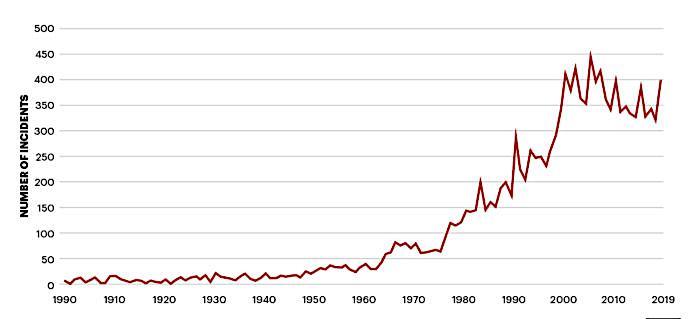

However, the most important (and most alarming) conclusion for scientists was not the fact of "global warming" itself but the fact that the Earth's climate is capable of changing much faster and more radically than we thought before, and humanity has no time to adapt to these climate changes either technologically, or evolutionary. In addition,someofthechangesthathavealreadyoccurred (an increasing concentration of CO2 in the Earth's atmosphere, acidification of the World Ocean with excess CO2, melting of Arctic/Antarctic ice) are irreversible. For example, a 2019 NASA report, indicated that approximately 10 gigatons of CO2 would need to be removed from the atmosphere each year until 2050 to limit global warming to 1.5°C (2.7°F), that is the goal of the Paris Climate Agreement 2015 [5]. In additional, since 1994 up to 2020, satellite imagery has revealed over 28 trillion tons of ice have melted in Greenland and Antarctica, as well as the Arctic and SouthernOceans[6]
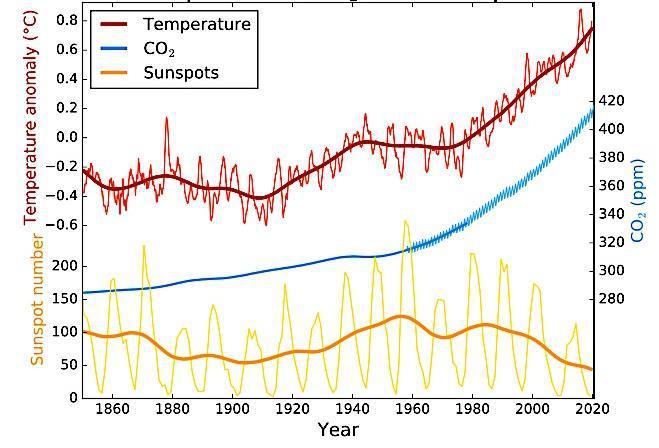
In my opinion, this is really impossible, and this is a senseless waste of huge efforts and huge money. I am sure that the hundreds ofbillions ofdollars allocated in the world for "the fight against global warming" are much more meaningful and important to spend on the adaptation of humankindtonewclimaticconditions. Rememberthewellknown proverb, “If the Great Flood is inevitable, one must spend the remaining time learning to live underwater.”
II. HURRICANES AND FLOODING
Here are some facts:
The monstrous hurricane Katrina literally destroyed New Orleans (Louisiana, USA) in 2005. Approximately 80% of the city area was underwater, 1836inhabitants died, approximately 700,000 people lost their homes, and economic losses reached $125 billion [7].
Floods in Thailand in 2011: a total of 65 of Thailand's 76 provinces were affected, 616 people died, more than 1.3 million people sought medical help, and 9.5 million people were left homeless. The total damage is estimated at $16 billion [8].
In July 2021, the state of Maharashtra and neighboring statesofIndiareceived theheaviestrainsinthelast40years. In some parts of the state, up to 600 mm of precipitation fell per day. The flood caused landslides in various parts of the
state. The total number of flood victims reached 213 people. Approximately 230 thousand people were evacuated [9].
In September 2022, hurricane Ian attacked the state of Florida (USA): 81 people died, hundreds of houses were destroyed, more than 2.6 million Florida residents were left without electricity, and damage was estimated at 40 billion USD [10].
Monsoonal downpours in Pakistan in autumn 2022 triggered floods and landslides that destroyed homes and infrastructure and claimed over 1,300 lives. According to the UN, the elements left tens of millions of people without a roof over their heads. A third of the country's territory is flooded, and crops and livestock are destroyed [11]
As seen from the above information, humanity around the world is constantly faced with the same consequences of hurricanes and floods:
A) The destruction of thousands of homes, especially 1-2-story private residential buildings;
B) Flooding of vast territories;
C) Mass de-energization of territories attacked by a hurricane;
D) These three factors lead to the death of people there. Thus, the engineering solutions to prevent these tragic situations are quite obvious, and these solutions have nothing to do with the ineffective "fight against global warming."
2.1. The destruction of thousands of homes
It is necessary to allow the construction of only "hurricane-resistant" residential and public buildings in any hurricane-prone areas. This is especially true for 1-2story residential houses. It should be monolithic concrete or foam concrete, and even better - reinforced concrete; load-bearing columns must be firmly fixed in the ground (Fig. 4) – [12].
All exterior walls and interior load-bearing walls should be supported on reinforced concrete strip footings. Interiorwallsmaybesupportedbythickeningtheslabunder the wall and suitably reinforcing it (Fig. 5). The foundations should generally be located on a layer of soil or rock with good bearing characteristics. In addition, 1-2-3-story residential buildings can be "printed" on giant 3D printers, as startups Shanghai “WinSun” or California's “Icon” do. 3D-printing a three-bedroom home can be fulfilled in 24 hours versus four weeks for typical the same building. *****

2.2. Flooding of vast territories
It is necessary in every hurricane- and flood-hazardous region of the world to carry out hydraulic engineering
https://dx.doi.org/10.22161/ijeab.81.11
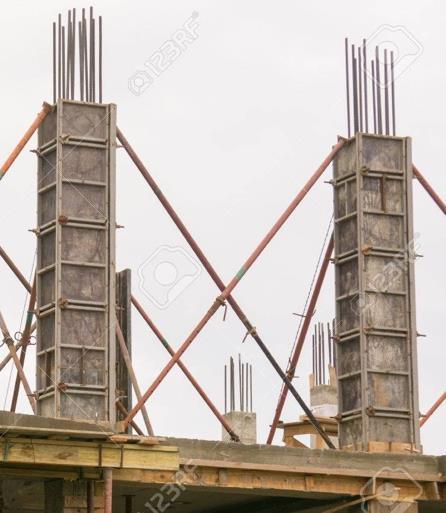
design of the necessary dams, as well as large drainage systems and then build them at any cost.
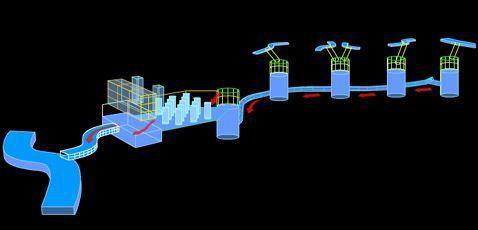
For example, flood control in the Netherlands began with the arrival of man in these places and continues to this day. The Zuiderzeewerken project included a dam system as well as land reclamation and drainage works. One of the main tasks of the project was the construction of a dam enclosing the large shallow bay Zuiderzee from the North Sea. For this, the Afsluitdijk dam was built, 30 km long, 90 m wide, and 7.25 m high above sea level. In the 1953 flood, Afsluitdijk dam paid for itself overnight, preventing dangerously high water from invasion of the central regions of the Netherlands [13]
Drainage systems for regions that are regularly flooded are also (such as dams) grandiose projects. One of the best, most efficient, and most impressive in the world is Tokyo's drainage system. The Tokyo Drainage System (TDS) [14] is one of the largest and most advanced in the world. It is located 15 km from Tokyo. It is designed to drain water during heavy rains and floods (the average rainfall in Tokyo in the rainiest October is 200 mm; the annual rainfall in Tokyo is 1520 mm).
The main underground hall of the TDS "Bath for Regulation Water Pressure" (it is sealed) has a size of 178x77 meters and a height of 18 m, and the vault is supported by 59 reinforced concrete columns (Fig. 7). The TDS gas turbine pumps (located in a separate fortified sealed bunker) are capable of pumping 200 m3/sec of storm water (that is, "1 standard swimming pool per second"). Everythingisautomated andcomputerized.Afterthelaunch of the TDS, the average level on Tokyo's streets of water decreased 10 times. The total area of the system is 6.5 km2 TDS had been under construction for 8 years - from 1992 to 1999. Project cost - 2 billion dollars.

2.3. Mass de-energization of territories attacked by a hurricane.
It has 5 huge wells every 1 km, each 70 m in height and 30 m in diameter. Wells connected with each other by large pipes (Fig. 6). The pipe diameter is 10 m, and all wells are connected by the same pipes to the Edogawa River (through a concrete dam).
Electrical power cables in all hurricane hazardous (as well as fire hazardous) areas should be laid exclusively underground through cryogenic superconducting underground cables in watertight and heat-resistant shells. Electrical power cables are built above the ground on metallic and even wood pillars; therefore every hurricane or forest fire leaves millions of people without electrical power.(Inaddition,wornhigh-voltagepowerlinesareoften themselves responsible for forest fires. For example, California-based Pacific Gas and Electric (PG & E) was found to be guilty for so-called Camp fires (California, 2018).
https://dx.doi.org/10.22161/ijeab.81.11
American Superconductor Corporation manufactures cryogenic superconducting cables for high voltage and high current electrical networks. This is a thin copper cable in an empty pipe of small diameter filled with liquid nitrogen. From above, the pipe (with a cable inside) is reliably covered with hydro- and thermal insulation. The use of such cables for high power networks (5 GW or more) over long distances (1-2 thousand km or more) can bring many benefits. First, the efficiency of power transmission over a superconducting cable is almost 100% (i.e. almost no losses; losses in conventional high-voltage networks - up to 10%). Second, a single superconducting cable for a 5 GW line will be ten times thinner than a normal copper cable. Third, a cryogenic cable can be laid underground with a "safety zone" of 5-10 m, while a conventional transmission line of the same power requires a right-of-way 100-200 m wide, and hundreds of metal poles 30-50 m wide (see Fig. 8). Fourth, I emphasize again that hurricanes, floods, and fires will not damage such an underground cable.
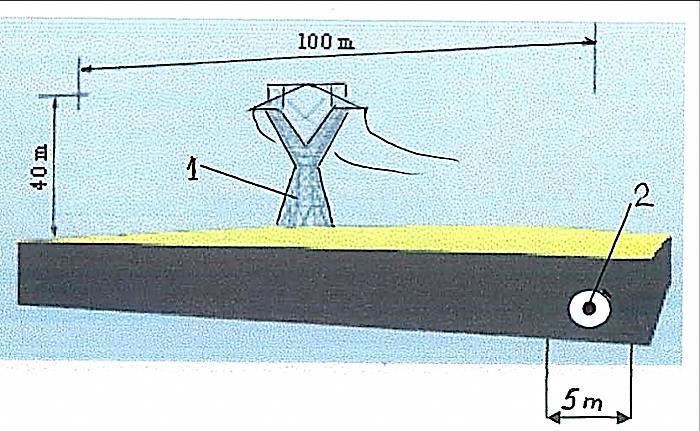
III. WILDFIRES
Wildfires are a huge disaster for our planet: humanitarian (death of people and animals), environmental, economic. In addition, forests are an important climate solution, absorbing carbon dioxide equivalent to more than 10% of annual greenhouse gas emissions
In the summer of 2017, more than 120,000 hectares of forest burned out in California, more than 70 people died, approximately 20,000 houses burned down, and the total damage exceeded $20 billion. Between 2021 and 2022, wildfires accounted for over $11.2 billion in damage across the United States [15].
As a result of wildfire in Australia in 2019 (8 million hectares of forests), at least 3 billion animals were affected. More than 60 thousand koalas, more than a million
2456-1878 (Int. J. Environ. Agric. Biotech.)
https://dx.doi.org/10.22161/ijeab.81.11
wombats, and several million kangaroos died; additionally, more than 143 million mammals, 2.5 billion reptiles, 180 million birds and 50 million frogs died in the fire [16].
From each hectare of forest fire, up to 100 tons of soot particles and up to 10 tons of toxic fire gases are emitted into the atmosphere [17].
The Dixie Fire in California (2021) was the largest wildfire in the history of the state, covering over 195,000 hectares. Pacific Gas & Electric told authorities that the fire may have started due to a short circuit when a burning tree fell on high-voltage wires.
Additionally, according to the data of the EU Joint Research, Europe in 2022 is experiencing the worst drought in 500 years. The drought caused forest fires and severely reduced crop yields.
How can wildfires be prevented and suppressed?
3.1. Clean out the old forest and restoring burnt forests
For example, the U.S. The government explained that the nation’s well-intentioned forest strategy over the past century has created an unnatural buildup of materials that act as kindling for wildfires. We urgently need around the world to start utilizing everything in the forests that kindle: dried twigs, dead trees, grasses, shrubs, and even old houses. For example, the area of such forests in the United States (California, Colorado, Oregon, other states) is approximately 50 million acres and will require approximately 50 billion dollars for 10 years [18]. Additionally, the US government has committed to helping deliver global goals to end natural forest loss by 2030 while restoring at least an additional 200 million hectares of forests to plant an estimated 1.2 billion trees that will sequester 75 million metric tons of carbon [18].
It is interesting that “Lockheed Martin Corp.” proposed creating new forests and restoring burned-out forests using “seed bombs” (Fig. 9). It can be done using the military airplanes C-130 (also known as the "Hercules") for mass planting trees by bombing. The possibilities are amazing. They can fly on 1,000 ft at 120 knots, planting more than

3,000 capsules a minute across the landscape and each capsule contains a sapling.
3.2. Extinguishing of wildfires
Theprocessofextinguishingtheflamehasa“threshold” character, i.e. for that, it is necessary to have a strictly 100% required amount of the firefighting agent for quite a long time simultaneously in any area of fire (including burning forest) that we extinguish [19]. Otherwise (in case of insufficient quantities of extinguishing agent or during pauses with its delivery), the fire will not subside but will flare up again and again and spread quickly.
The norm for extinguishing burning firewood is 0.3 kg/m3 of flame (it could be ammonium phosphate). However, these 0.3 kg should be in EVERY m3 of burning wood CONTINUOUSLY for at least 30 minutes [19]. The precipitation velocities calculated from the well-known Stokes law for single particles (ammonium phosphate) of 100, 50, and 5 micron diameter are 63, 15, and 0,3 cm/s, respectively. However, the precipitation of an aerosol cloud of the firefighting powder inside a turbulent flame is a much more complex process.
Therefore, for example, California (and all other firehazard regions of the world) should be sufficiently completed by aircrafts and helicopters with large load capacity for firefighting. The problem is that the ALL area of the fire must be COMPLETELY covered by a fire extinguishing agent (powder, foam, water). To do this, it needs to have a big squadron of fire planes (several tens), so that when the last plane will drop the fire extinguishing agent on the flame, the first one would have time to recharge and to arrive at the fire. They need a nonstop “aviation fire extinguishing carousel" over the wildfire!
3.3. Fire resistant houses
As in the case of hurricane-prone areas, similar recommendations apply for fire-prone areas: it is necessary to allow the construction of only "fire-resistant" residential and public buildings in any fire-prone areas. This is especially true for 1-2-story residential houses. It should be monolithic concrete (see Fig. 4). However, in this case, it will be the so-called refractory or heat-resistant concrete Saunas and fireplaces are usually made from such concrete for ordinary housing. Additionally, for fire-hazardous regions, additional processing of the outer layer of concrete with special heat-resistant coatings is necessary. For example, researchers at the Nanyang Technological University (NTU) in Singapore have invented an invisible coating thatcanbeappliedtowood to make itfireproof.The coating is transparent and just 0.1 mm thick, and it is
invisible to the naked eye. When exposed to fire, the coating becomes a char that is more than 30 times its original thickness [20].
Since forest fires completely destroy electrical networks, for fire-prone regions electrical power cables should be laid exclusively underground through cryogenic superconducting underground cables (see Fig. 8).
IV. GREEN ENERGY
4.1. Sunlight and Wind
The average flow of solar energy reaching the Earth's surface is 200-250 W/sq.m, while human economic activity requires only 15-20 W/sq. m. for highly industrialized countries and no more than 3 W/sq. m for poor countries. Thatis,theoretically,itisenoughtouseupto8-10%ofsolar energy to fully meet the energy needs of mankind without using of fossil fuels at all.
After 2040 (via 20 years only!) solar, wind and hydrogen energywillalmostcompletelyreplacecoalandoil and partly replace gas. According to UN Environment Program (UNEP) data, by 2025, 1 "green kWh” of energy will cost as much as 1 "coal kWh”. Electric cars will be on the roads (by 2040, 90% of all sold motor cars in the world will be electrical). Aircraft will also fly through electrical energy. In the total energy balance of world electricity production for 2021 (28,500 terawatt-hours), the share of solar and wind generation exceeded 10% for the first time. The introduction of generation based on renewable energy sources (RES) in the world by 2030-2035. will reach a record level: 740 GW will be introduced in the EU, and the US will be able to provide up to 40% of the country's electricity (approximately 1500 GW); also, over the next 10 years, offshore wind energy in the world will “add” more than 200 GW [21].
The main advantage of green energy (sunlight, wind, water flow) over fossil fuels (coal, oil, and natural gas) is not only curbing climate change. When comparing the price of "green" and "fossil" kilowatt, economists usually don’t take into account that green energy sources (unlike fossil fuels) don’t need to be sought (by geologists), mined, transported to a power plant in order to incinerate in furnace of steam boiler ("green energy" can be supplied directly to consumers.)
That is, in replacing fossil fuels with green energy (sunlight plus wind), humanity is moving on the right track, and moving quickly and confidently
https://dx.doi.org/10.22161/ijeab.81.11
4.2. Small hydropower stations
"Small hydropower station" (SHPS) uses the energy of the flow of rivers (the capacity of such flow SHPS does not exceed 30 MW), as well as the energyof ocean and sea tides (the capacity of such tidal SHPS does not exceed 300 MW). For comparison, the world's largest hydroelectric power plant, the “Three Gorges” (China), has a capacity of 22,500 MW But for this, the huge Yangtze River was completely blocked by a dam in which 65 million tons of concrete were laid (https://www.britannica.com/topic/Three-GorgesDam). For example, in France, the total capacity of the all SHPS is approximately 2000 MW but this is less than 2% of the total electricity generated in France. However, the average cost of 1 kW/h of such hydroelectric power is only $0.05 but the price of a typical 1 kW/h is $0.15, three times higher.
4.3. Ecological nuclear power
Nuclear power is neither strictly renewable nor fully green for well-known reasons. Natural uranium contains 99.3% 238U and only 0.7% 235U. However, only the 235U isotope is suitable as fuel for conventional nuclear reactors. Therefore, natural uranium has to be enriched - it is expensive and dangerous as dangerous traditional nuclear power stations in general. The main ways to "more green" future nuclear technologies are as follows:
1) Stop using enriched uranium-238 as fuel, switch to unenriched (or depleted) uranium, and even better, safe thorium;
2) Switch to nuclear technologies based on fast neutrons, while using unenriched uranium, as well as afterburning highly radioactive waste to their minimum radioactivity in breeder reactors;
3) Switch to the production of small modular nuclear reactors (SMNRs) with a capacity of up to 300 MW. SMNRs can also be used in conjunction with renewable energy sources to improve their efficiency in hybrid cogeneration.
As a result of using the mentioned technologies, not only will it be possible to save up to 25% of natural uranium reserves, butthe averageburnup ofnuclear fuel will become several times greater. Additionally, the accumulation of dangerous isotopes of trans-uranium elements in its slag will be several thousand times less.
A series of small modular nuclear reactors (SMNRs) is now being created on the basis of the mentioned technologies. For example, Hyperion Power Generation Company (USA) has developed a compact Hyperion Power Module (capacity 25 MW) (Fig. 10). In addition, Terrapower (USA) has created a traveling wave reactor (TWR) that uses depleted uranium and is able to operate for 100 years without fuel refueling. A similar, but ultracompact 4S reactor (10 MW) has already been developed by Toshiba (Japan), whose operation life is 30 years without fuel refueling.
In addition, the US Department of Energy recently selected 5 small modular nuclear reactors (SMNRs) to receive government support:
• BWXT's Advanced Nuclear Reactor, a mobile microreactor using TRISO fuel for use in remote areas with no centralized power grid (TRISO is the most efficient and safest nuclear fuel in the world);
• Westinghouse eVinci microreactor, also using TRISO fuel;

• Hermes reactor - a smaller version of the high-temperature Kairos Power reactor using molten fluoride as a coolant (KP-FHR);
• Pressurized water reactor SMR-160 developed by Holtec;
• Molten salt (molten chloride) reactor developed by Southern Company Services Inc.
4.4 Heating houses using heat pumps
Unfortunately, human civilization has gone on a dangerous and inefficient way of energy production by incinerating fossil fuels (coal, gas, and oil). However, I would like to pay attention to the fact that the nature has created other grandiose thermal energy source for mankind - it is so-called "secondary" solar energy (i.e. utilization of heat of the upper layers of oceans, seas, rivers, and ground and the lower layer of the atmosphere). This "secondary"
solar energy can be utilized with the help of so-called heat pumps (Fig. 11)

The heat pump works like a "refrigerator in reverse" - the interior heats up, and the environment (a section of a river, ground or surrounding atmosphere) cools. The heat carrier here is liquid ammonia (-40 °C). Therefore, if a coil with liquid ammonia is immersed ina river (lake) or buried in the ground, then even in winter (-5 °C), this water or ground will be "hot" for liquid ammonia, and it will evaporate and will perform work, and water (ground) around the coil - will be cooled.

Depending on the type of heat pump (ground-to-air, water-to-water, etc.), the theoretical efficiency of heat pumps can reach 80% (Fig. 12).
Fig 13 The scheme of a “non-fuel” power station (NFPS) (Krasnyansky’s project):
1 - condenser; 2 - compressing of the more hot gasiformammonia (+80 ºC); 3 - more hot water (+70 ºC); 4 - heatexchanger, combined with the Stirling-engine and the electric-generator; 5 - less hot water (+30 ºC); 6compressor; 7 - compressing of the less hot gasiformammonia (+30 ºC); 8 - choke; 9 - fluid-ammonia ( -40 ºC); 10 - evaporator; 11 – water pump; 12 - more cold water (+ 5 ºC) into river; 13 - less cold water (+ 10 ºC) from river
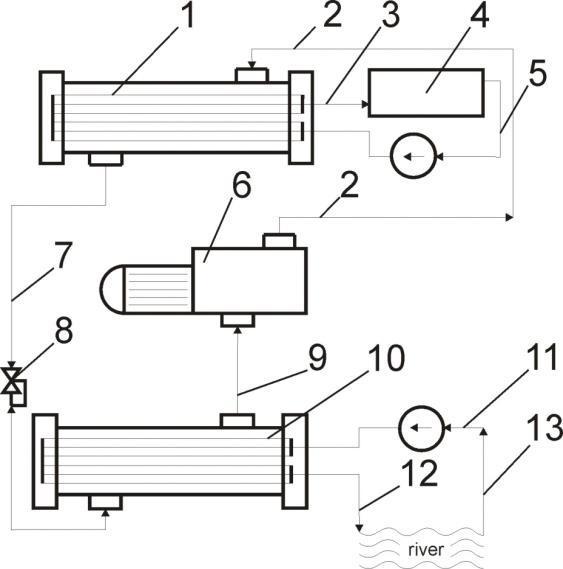
However, in countries with a hot climate there is no need for space heating and use of heat pumps for this. However, at the same time, the heat pumps can be turned into a source of electricity (especially given huge excess heat in such countries). If we combine in a united cycle a heat-pump, the Stirling engine (this is an "external combustion" engine), and a heat-exchanger (Figs. 13 and 13a) - we shall have so-called "non-fuel power station" (NFPS)wheretransformationofheatintousefulmechanical work and further into electricity will occur with high efficiency.
1 -energy spent for work of the heat-pump; 2 - energy received from work of a heat pump (especially if to combine a heat pump with solar panels on the house roof)

ISSN: 2456-1878 (Int. J. Environ. Agric. Biotech.)
https://dx.doi.org/10.22161/ijeab.81.11
engine of external combustion); 2 – heat-exchanger of the NFPS; 3
shaft of the Stirling-engine; 4 - generator of an electric current; 5 – electric current for consumers. Herewith:
a) the cost of heating a home/office will be decreased;
b) the use of fossil fuels will decrease;
c) the negative change of a climate will be decreased (because you will pump out superfluous heat from the environment).
For example, for present German consumers, the cost for the electricity needed to power a heat pump is approximately 35% cheaper than natural gas, according to the German company Verivox.However, the high purchase and installation price (approximately 30,000 euros) of the heat pump can run up to three times that of a conventional gas furnace (NYT, Dec. 5, 2022.)
4.5. Zero-Energy Houses
In the last decade, the world has become popular with socalled “zero-energy houses”, i.e. buildings that are highly energy efficient, able to independently generate and save energy and consume it from their own sources all the time [22] Such buildings are now being intensively built around the world: FKI Tower and "Dancing Dragons", (Seoul, South Korea), Hikari Lyon (France), New-Blauhaus (Mönchengladbach, Germany), Manitoba Hydro Place (Winnipeg, Canada), Clean Technology Tower (Chicago, USA), and others. In additional, China built a 300-meter 70-story "Pearl River Tower" in the city of Guangzhou. It's a skyscraper with "zero energy"(Fig. 14).
That is, it will not consume electricity from the external network, and will also consume almost no water. The house will use wind and solar energy. The curved facades of the Tower are designed to direct the wind into special "vents blown through" that are on each of the floors and where wind turbines are installed. Along the façade, there are rows of solar panels (photovoltaic panels) that supply electricity to the home's batteries. In addition, solar thermal collectors are installed on the building, which heat water for the inhabitants of the skyscraper. The project includes a rainwater collection system, as well as a wastewater treatment and recycling system, which should minimize the house's need for an external water source.

Theauthorofthisarticleproposed hisownproject"Zero Energy House" adapted to the technological capabilities of the so-called "developing countries" (Fig. 15).
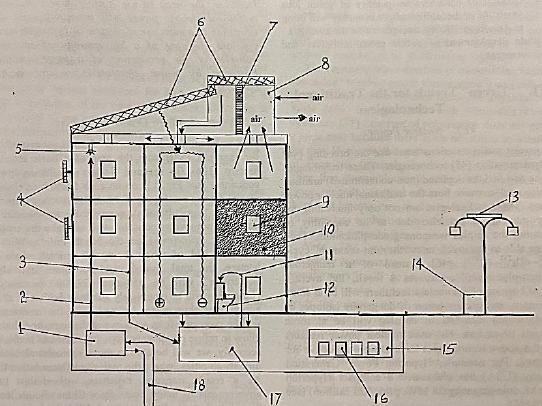
https://dx.doi.org/10.22161/ijeab.81.11
1 – heat-pump; 2
warm water; 3
cool water; 4
microwind-turbines; 5
light-emitting diode; 6 – solar panel; 7
air filter; 8 – air-exchanger; 9 – "photovoltaic windows" that serve as an additional electricity generators; 10
super-insulation; 11
water after cleaning; 12
toilet; 13 – solar panel; 14 – electrical accumulator; (13 and 14 – are a street lamp post with independent generation of the electric power); 15 – laundry; 16
“dry” washingmachines (without using of water and any detergent); 17
bio-chemical cleaning of the sewage; 18 – coil with liquid ammonia
In addition, the British company "iHelios" produces electric infrared "wallpaper" that can heat a residential or office space. In fact, these are the thinnest metal sheets hidden behind plaster walls or real wallpaper and connected to the electrical network.
V. GREEN TRANSPORTATION
Currently, more than one billion internal combustion engines are in operation worldwide (cars and trucks, diesel locomotives, tractors, agricultural and construction equipment, armored vehicles, airliners, etc.), which annually burn approximately one and a half billion tons of motor fuel (gasoline, diesel fuel, jet fuel), and they pollute the atmosphere with toxic and greenhouse gases
The efficiency of an internal combustion engine is lowat best 30%, on average 25% (see Fig. 16).

Volkswagen (https://www.volkswagennewsroom.com/en) gave interesting statistics for Europe: the average speed of urban transport in the majority is 22 km/h; however, with such meager indicators, these cars consume an average of [10 (cars) -15 (pickup trucks, minibuses) - 25 (buses)] liters of motor fuel per 100 km. Most of this fuel is burned at traffic lights or traffic jams; for small trucks - also for small loading and unloading; in the case of passenger transport - at stops with the engine running.
In addition, a dense network of high-speed (200-300 km/h) electric railways for public transportation (electric trains, subway, etc.) is also an effective way to reduce the consumption of petroleum products (after all, electricity can be obtained without using fossil fuels). China is the "champion" of this kind of transport: their length is 35,000 km, followed by Germany - 3,600 km. For example, the total length of the French Train à Grande Vitesse (TVG) is 1700 km with 149 stations. It carries approximately 40,000 passengers per day (about 12 million per year) at a speed of 320 km/h. If these passengers used private cars, they would use up annual 100,000 tons of gasoline (https://en.wikipedia.org/wiki/TGV).
Alice, an electric aircraft developed by Israeli startup Eviation (https://www.eviation.com), flew to 3,500 feet and stayed in the air for 8 minutes. Alice is a nine-seat regional aircraft for two crew members and nine passengers with a range of up to 830 km and a speed of up to 460 km/h; load capacity 1.1 tons.
That is, in replacing traditional gasoline and diesel vehicles with electric vehicles, humanity is also moving on the right track but is not moving fast enough.
VI. ALTERNATIVE AGRICULTURE
Therefore, the US, EU, China, and Japan have already committed themselves to completely stop the production of gasoline and diesel cars by 2040 and switch to electric vehicles. Urban and intercity transport also needs to be converted to electricity, or at least replaced with “hybrids”, so that at traffic lights, in traffic jams or at stops, it does not waste fuel in vain, but charges its battery.
Agriculture is one of the most powerful sources of greenhouse gases. When sowing, harvesting, and transporting agricultural products around the world, millions of tons of gasoline and diesel fuel are burned. Cattle breeding creates additional problems. Here, there is a low efficiency of the conversion of vegetable proteins into animal one Therefore, it is necessary to grow approximately 8-10 kg of vegetable protein in the form of forage for cattle to produce 1 kg of animal protein in the form of, for example, beef; that is, the energy efficiency of this process is only 10-15%. Additionally, animal husbandry requires 4-5 times more water than forage production: 15,000 liters of fresh water are needed to produce 1 kg of beef, and only 4,000 liters are needed to produce 1 kgof beans. In addition, a typical cow "produces" and releases 400-500 liters of the greenhouse gas methane (which is a side effect of its digestive processes) into the atmosphere per day, and there are approximately 1.5 billion cows in the world. I.e. cows are responsible for 10% of total greenhouse gas emissions [24]. Vegetable protein (which contains all eight "essential" amino acids) is significantly superior to cattle meat in all medical, environmental and economic indicators.
The way out for humanity is, first, a complete rejection of cattle breeding (with the preservation of much more environmentally friendlypoultry farming)andthe transition to “artificial meat” and “artificial milk”; second, partial
transfer of crop cultivation to large cities with help of the so-called "vertical farms".
6.1. Artificial meat (cultured meat, grown meat)
The process of producing artificial meat involves obtaining stem cells from animal muscles and using a special protein that allows the cells to grow into larger pieces of meat [25, 26]. An artificial "meat plant" requires much less land (only 1% of the land compared to a conventional farm of the same meat productivity). In addition, under sterile artificial conditions, you can obtain an environmentally friendly product without any toxic metals, worms, giardia and other "troubles" that are often present in raw meat. Additionally, artificially grown meat does not violate moral standards: there will be no need to raise livestock, and then ruthlessly kill them. Growing meat in vitro requires five times less energy and 10 times less water than conventional production of the same amount of beef and reduces greenhouse gas emissions by 20 times compared to raising livestock for slaughter. Microsoft founder Bill Gates, Google co-founder Sergey Brin, and famous actor Leonardo DiCaprio invested in the development of artificial meat
The Good Meat company [27] plans to start building the complexoftheworld'slargestbioreactorsfortheproduction of artificial meat. Commissioning of the equipment is scheduled for the end of 2024. The company plans to grow artificial beef and chicken.
There is also vegetable (vegan) meat (it is made from vegetable protein - pea, bean, and vegetable oil (usually rapeseed).Such "meat"ismanufactured andsoldbyBeyond Meat Corp. (https://www.beyondmeat.com/en-US/).
Perfect Day (https://perfectday.com), a Silicon Valley startup, has developed "artificial milk" technology. Perfect Day uses a completely new technology: its "milk" is produced by yeast. To do this, nutritional yeast DNA was genetically modified so that the microorganisms produced milk proteins, including casein, lactoglobulin and lactalbumin. The company believes that its technology couldbecomethebasisforcreatingimitationsofmanydairy products, from cheeses to yogurts.
The American startup Brown Foods (https://www.ycombinator.com/companies/brown-foods) introduced artificial milk made using cell culture technology. The founders of the startup claim that the resultingproductissimilarinpropertiesandtexturetocow's milk. The startup slogan is “Making real milk without any cows!”
A vertical farm is a highly automated agricultureindustrial complex for growing crop plants using hydroponics or aeroponics methods indoors inside a specially designed building. The main differences between vertical farms and traditional greenhouse farms are multitiered plantings (Fig. 17) and a fully controlled indoor climate. The modern use of multilevel racks in combination with LED-based phyto-lighting, irrigation and fertilizer automation allows vertical farms to increase yields per unit area by 5 or more times compared to traditional farming methods. It is noted that production on a vertical farm is approximately ten times more efficient than in greenhouses and a hundred times more efficient than in an open field [28]
Vertical farm projects have the following benefits [29]:
• crop stability, which does not depend on natural conditions;
• application of water collection and purification systems that reduce water consumption by 95% compared to traditional agricultural production;
• closed ventilation cycle, purification and ionization of air in the growing rooms, which makes it possible to exclude the occurrenceofpestsandphyto-pathologies, as well as the use of pesticides, herbicides and insecticides;
• possibility of location within city limits, in particular, in repurposed industrialinfrastructurefacilities,whichreduces transportation costs and transportation losses by dozens of times;
• energy independence (when using solar and wind energy).
In addition, vertical farms are a faster and more efficient response to severe droughts than long-term breeding of drought-tolerant agricultural plants.

6.3. Losses in food chains
According to the World Health Organization, in 2020, out of 7.5 billion people living on the planet, approximately 800millionpeoplewerepartiallyorcompletelyhungry.The world annually produces approximately 4 billion tons of food, and this could be enough for all the inhabitants of the planet if food was rationally used and distributed.
Food disappears at all stages of production - during collection, processing, storage, transportation to retail chains and food outlets [30].
Globally, approximately 14% of food produced is lost between harvest and retail, while an estimated 17 percent of total global food production is wasted (11% in households, 5% in food services and 2% in retail) [31]. However, in the so-called developed countries, this figure is even higher; for example, in the United States, approximately 30% of food is thrown away (on average, an American family of four throws $2,000 worth of food every year) [32]. At the same time, it must be emphasized that we are not talking about food waste but about food products suitable for consumption. Thus, we are not talking about, for example, potato peels, but about unused, usable potatoes, which became “food waste” only after they were thrown into the trash can.
The result is that unused food consumes approximately a quarter of all freshwater consumed, as well as 300 million barrels of oil per year.
Thus, measures to prevent large crop losses, and especially extensive measures to prevent usable food from being wasted, will not only help overcome hunger on the planet but also prevent the useless burning of millions of tons of oil products, which will significantly reduce the emission of greenhouse CO2 into the atmosphere.
VII. THE SICK WORLD OCEAN
The World Ocean is a great helper of humankind in adapting to climate change. UNESCO Director-General Audrey Azoulay said: "The ocean is the heart of our planet. Humanity cannot live healthy if our oceans are sick."
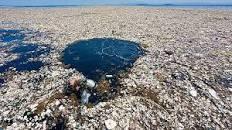
The world's oceans absorb more than 90% of the excess atmospheric heat and approximately one-third of the carbon dioxide emitted by industry and transport. As the analysis showed, for the entire period of observations (1955-2020), the thermal energy stored in the waters of the world ocean increased by 380 zettajoules (zetta is 10²¹). More than half of this heat is concentrated in the upper layers of the ocean (at a depth of up to 200 m). Warmer
oceans contribute to severe storms and hurricanes and increase the risk of flooding [33].
Additionally, due to the greatly increased content of CO2 in the atmosphere (and, consequently, its high partial pressure), the world ocean absorbs an increased amount of CO2 Therefore, for 13 years (from 1994 to 2007), the world ocean "removed" 34 billion tons of CO2 from the atmosphere, which is approximately 30% of the total global CO2 emissions for this period [34]. Scientists believe that this level of CO2 uptake by theocean will continue for many more years. As a result, of which acidification of the world ocean occurs, i.e. decrease in pH (since 1890, ocean acidity hasincreased,andpHhasfallenfrom8.2to8.1,andinsome areas even to 8.0) [35]. (For example, although it is still weakly alkaline water, it is no longer alkaline enough for corals, mollusks, and other marine organisms, and they “die en masse”.)
By absorbing excess heat and carbon dioxide, the oceans slow down climate change, but this negatively affects aquatic ecosystems. After all, the world ocean is also a source of food and livelihood for several billion people on the planet.
Unfortunately, the oceans are increasingly turning into the world's garbage dump. For example, a huge floating "island" of plastic debris was found on the surface of the Pacific Ocean between California and the Hawaiian Islands [36] (Figs. 18). The mass of plastic is estimated at three million tons (80% - plastic bottles and containers), and the area is approximately 1 million square km. However, research conducted by Australian scientists has shown that there are additionally approximately 15 million tons of plastic waste less than 5 mm in diameter at the bottom of the world's oceans, which is 5 times the mass of plastic that "floats" on the surface of the ocean - 3 million tons. Plastic debris in the Pacific is responsible for the deaths of millions of seabirds and marine animals. Thus, Spanish
environmentalists in 2018 found more than 29 kilograms of plastic in the stomach of a dead 10-metre sperm whale [37].
An analysis of the changes in the conditions of human life on Earth allows us to draw the following conclusions:
1. Climate change on the Earth has led to a sharp increase in hurricanes, floods, wildfires, droughts and other natural disasters, and it has led to a huge increase in financial damage to federal and local budgets.
2. In replacing fossil fuels with green energy (sunlight plus wind), humanity is moving on the right track and moving quickly and confidently. In replacing traditional gasoline and diesel vehicles with electric vehicles, humanity is also moving on the right track but is not moving fast enough.
As shown in Fig 19, a plastic bottle from the "garbage island" is literally covered with mollusks, crabs, and barnacles that bite off microparticles of plastic from the bottle. These clams and crabs will then be eaten by larger fish, and these microplastics will move up the food chain, ending at the human dinner table.
How can the world ocean be protected from plastic waste?

A) Avoid plastic bags. TheUS and Europe, then Canada and Australia are phasing out plastic bags. Kenya and Tanzania have recently joined. The new rules will force shoppers to reorganize: if they previously received plastic bags for free in stores, now they will be forced to carry their own shopping bags with them or buy cloth bags at the store checkout for little money.
B) For plastic bottles and plastic containers - the transition to biodegradable plastic. Such plastic has already been created in laboratories (https://www.sciencenews.org/)
Bioplastics are plastic materials produced from renewable biomass sources. Therefore, scientists from the University of California, Berkeley, developed such plastic for packaging. With moderate heat, enzyme-laced films of this plastic disintegrate within some weeks. British startup Polymateria has also developed a completely biodegradable plastic.
VIII. CONCLUSIONS AND RECOMMENDATIONS
The recipe for solving all the previous problems of mankind was the transition to a higher technological stage: from a raw food diet to making a fire, from picking berries and nuts to settled agriculture, from the Stone Age to the Iron Age, and from a horse to a "Ford". Climate change problems must be approached in the same way.
3. It is necessary to strengthen building codes. It is necessary to allow the construction of only "hurricane-resistant" residential and public buildings in any hurricane-prone area. This is especially true for 1-2-story residential houses. It should be monolithic concrete or foam concrete, and even better - reinforced concrete; load-bearing columns must be firmly fixed in the ground
4. As in the case of hurricane-prone areas, similar recommendations apply for fire-prone areas: it is necessary to allow the construction of only "fireresistant" residential and public buildings in any fire-prone area. This is especially true for 1-2-story residential houses. It should be monolithic concrete (Fig. 4). However, in this case, it will be the socalled refractory or heat-resistant concrete or fireclay.
5. In areas prone to flooding, it is necessary to design and build powerful dams and/or breakwaters, and also powerful drainage systems such as the Tokyo drainage system.
6. Electrical power cables in all hurricane hazardous (as well as fire hazardous) areas should be laid exclusively underground through cryogenic superconducting underground cables (Fig. 8), in watertight and heat-resistant shells.
7. Hazardous fire regions should be sufficiently completed by aircraft and helicopters with a large load capacity for firefighting. All areas of the fire must be completely covered by a fire extinguishing agent (powder, foam, water).
8. To prevent wildfires, we urgently need to start utilizing everything in the forests that kindle: dried twigs, dead trees, grasses, and shrubs. It will be faster to restore burnt forests with the help of "seed bombs".
9. It is necessary to return to nuclear power but to small modular nuclear reactors (SMNRs) with a capacity of up to 300 MW. With their help, low-
enriched uranium and even nuclear waste from traditional reactors can be used as fuel.
10. We need to use heat pumps much more to generate heat pumping out "excess heat" from the environment
11. The world has become a popular so-called “zeroenergy house”, i.e. a building that is highly energy efficient, able to independently generate and save energy and consume it from its own sources throughout the year.
12. It is necessary to abandon cattle breeding (while maintaining more environmentally friendly poultry farming) and switch to artificial meat and milk.
13. Cultivation of agricultural crops should be transferred into so-called vertical farms. A vertical farm is approximately 10 times more efficient than a greenhouse and 100 times more efficient than in an open field.
14. Minimize food wastage at all stages - from harvesting and storing crops to discarding expired products.
15. It is necessary to completely abandon the current bio-non-degradable plastic in favour of biodegradable plastic.
After reading this section, any government official will say: "It's too much expensive!" Well, but 20-30-40 billion dollars damage every year - is it NOT expensive?
REFERENCES
[1] IPCC IntergovernmentalPanelonClimateChange. (2019).Ipcc.ch;IPCC.https://www.ipcc.ch/
[2] R Rohde.(2021,January14).GlobalTemperatureReportfor 2020 - Berkeley Earth. Berkeley Earth. https://berkeleyearth.org/global-temperature-report-for2020/
[3] E. Monnin Indermuhle A, Dallenbach A, Fluckiger J, Stauffer B, Stocker TF, Raynaud D, Barnola JM. Atmospheric CO2 concentrations over the last glacial termination. Science.2001Jan5;291(5501):112-4.
[4] D. Lewis (2020, October 27). Increasein Natural Disasters on a Global Scale by Ten Times. Vision of Humanity. https://www.visionofhumanity.org/global-number-ofnatural-disasters-increases-ten-times/
[5] NASA,NOAAAnalysesReveal2019SecondWarmestYear on Record. (2020, January 15) https://climate.nasa.gov/news/2945/nasa-noaa-analysesreveal-2019-second-warmest-year-on-record/
[6] K.Cassella (2021,January12).28TrillionTonsofIceHave Melted Since 1994, on Track With Worst-Case Scenarios. Science Alert-Environment. https://www.sciencealert.com/the-rate-at-which-earth-s-iceis-disappearing-is-on-track-with-our-worst-fears
[7] R.D. Knabb, J.R. Rhome, D.P. Brown. Tropical cyclone report.HurricaneKatrina23-30August2005 (2023, Jan.4)
https://www.nhc.noaa.gov/data/tcr/AL122005_Katrina.pdf
[8] Thailand Emergency Operation Center report for Flood, StormandLandslide.(2012,Jan.17).
https://reliefweb.int/disaster/fl-2011-000135-tha
[9] Maharashtra Rains: Mahabaleshwar record 600 mm rainfall in24hour(2023,January7)
https://en.gaonconnection.com/mahabaleshwarmaharashtra-rains-kolhapur-uddhav-thackeray-floodslandslides-ndrf-rescue-operations-navy/
[10] W. News. (2022). The Point, Sept. 29, 2022: Hurricane Ian devastates Southwest Florida as one of the most powerful storms to hit the state. WUFT News.
https://www.wuft.org/news/2022/09/29/the-point-sept-292022-hurricane-ian-devastates-southwest-florida-as-one-ofthe-most-powerful-storms-to-hit-the-state/
[11] Climate change likely increased extreme monsoon rainfall, floodinghighlyvulnerablecommunitiesinPakistan – World Weather Attribution. (2022). Worldweatherattribution.org. https://www.worldweatherattribution.org/climate-changelikely-increased-extreme-monsoon-rainfall-flooding-highlyvulnerable-communities-in-pakistan/
[12] OrganizationofAmericanStates(OAS).CaribbeanDisaster Mitigation Project, Concrete Construction (2001, April 20)
https://www.oas.org/cdmp/document/codedraw/sectionb.htm
[13] Holland - land of water (a story about Afsluitdijk dam) https://www.hollandlandofwater.com/afsluitdijk/
[14] L Grozdanic.(2014,January18).Huge3DPrinterCanPrint an Entire Two-Story House in Under a Day... InhabitatGreen Design, Innovation, Architecture, Green Building | Green Design & Innovation for a Better World; Inhabitat. https://inhabitat.com/large-3d-printer-can-print-an-entiretwo-story-house-in-under-a-day/
[15] D Arguedas Ortiz. (2019). The underground cathedral protecting Tokyo from floods. Bbc.com. https://www.bbc.com/future/article/20181129-theunderground-cathedral-protecting-tokyo-from-floods
[16] 2019 WWF-US ANNUAL REPORT. (n.d.). Retrieved January 7, 2023, from https://files.worldwildlife.org/wwfcmsprod/files/FinancialRe port/file/7m1y8wax5s_WWF_AR2019_FINALPAGES.pdf
[17] M. Sleight (2022, September 22). U.S. wildfire statistics 2022. Bankrate; Bankrate.com https://www.bankrate.com/insurance/homeownersinsurance/wildfire-statistics/
[18] TheWhiteHouse.(2022,April22).FACTSHEET:President Biden Signs Executive Order to Strengthen America’s Forests, Boost Wildfire Resilience, and Combat Global Deforestation | The White House https://www.whitehouse.gov/briefing-room/statementsreleases/2022/04/22/fact-sheet-president-biden-signsexecutive-order-to-strengthen-americas-forests-boostwildfire-resilience-and-combat-global-deforestation/
[19] M. Krasnyansky. Remote extinguishing of large fires with powder aerosols. Fire and Materials: An International Journal.2006Sep;30(5):371-82.
[20] A.Paleja.(2022,August22).Afireproofwoodachievesthe highest class in burning test thanks to an invisible coating. Interestingengineering.com; Interesting Engineering. https://interestingengineering.com/innovation/invisiblecoating-fireproofswood?traffic_source=Connatix
[21] World Energy Outlook 2021
Analysis - IEA. IEA. https://www.iea.org/reports/world-energy-outlook-2021
[22] A.Fixsen (2020,July7).HowtoDesignaNet-ZeroHome. Architectural Digest; Architectural Digest. https://www.architecturaldigest.com/story/how-to-design-anet-zero-home
[23] Pearl River Tower
SOM. (2022, August 24). SOM. https://www.som.com/projects/pearl-river-tower/
[24] M. Krasnyansky “Energy Saving”, textbook. (Ukrainian language), PublishingHouse"Condor",Kyiv,2018,134p.
[25] J. Vein. A method of producing meat from farmed muscle tissue for consumption. USPatent 6,835,390 (Priority to 2001, November 16) https://patents.google.com/patent/US6835390B1/en
[26] R. Robin. Test tube meat. TheNewYorkTimes(daily newspaper);(2005,December11)
https://www.nytimes.com/2005/12/11/magazine/in-vitromeat.html
[27] D. Carrington (2022, May 25). World’s largest vats for growing “no-kill” meat to be built in US. The Guardian; The Guardian.
https://www.theguardian.com/environment/2022/may/25/wo rlds-largest-vats-for-growing-no-kill-meat-to-be-built-in-us
[28] D. Despommier.Theverticalfarm:feedingtheworldinthe 21stcentury.Macmillan;2010Oct12.
[29] S.H. Van Delden, M. SharathKumar, M. Butturini, et al Current status and future challenges in implementing and upscaling vertical farming systems. Nature Food. 2021 Dec;2(12):944-56.
[30] UNEP Food Waste Index Report 2021. UNEP - UN Environment Programme. https://www.unep.org/resources/report/unep-food-wasteindex-report-2021
[31] E.L.Barrera,T.Hertel.Globalfoodwasteacrosstheincome spectrum: Implications for food prices, production and resourceuse.FoodPolicy.2021Jan1;98:101874.
[32] United Nations (2014). Food Loss and Waste Reduction | United Nations. United Nations; United Nations. https://www.un.org/en/observances/end-food-waste-day
[33] Theroleof theoceanintemperingglobal warming. (2022). NOAA Climate.gov. https://www.climate.gov/newsfeatures/blogs/enso/role-ocean-tempering-global-warming
[34] Oceansinkforman-madeCO2 measured.Phys.org;Phys.org (byETH Zurich), 2019, March 15. https://phys.org/news/2019-03-ocean-man-made-co2.html
[35] P.G. Brewer & J. Barry (2008). The Other CO2 Problem. Scientific American, 18(4), 22–23. https://doi.org/10.1038/scientificamericanearth0908-22
[36] L.Lebreton,B.Slat,F.Ferrari,atal.EvidencethattheGreat Pacific Garbage Patch is rapidly accumulating plastic. Scientificreports.2018Mar22;8(1):1-5.
[37] M.Haag.64poundsoftrashkilledaspermwhaleinSpain, ScientistsSay.NewYork:TheNewYorkTimes(2018,April
https://www.nytimes.com/2018/04/12/science/sperm-whaledeath-spain.html
